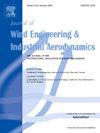Stochastic flutter of wind turbine blades under turbulence and load perturbations: Implications on offshore wind energy
IF 4.2
2区 工程技术
Q1 ENGINEERING, CIVIL
Journal of Wind Engineering and Industrial Aerodynamics
Pub Date : 2025-02-17
DOI:10.1016/j.jweia.2025.106041
引用次数: 0
Abstract
The current trend in offshore wind energy is to design and install blades with larger swept areas that yield unprecedented efficiency. Long and slender blades are needed to achieve this objective. As a result of aerodynamic and structural tailoring, the blades are sensitive to various dynamic instability phenomena during standard operations. Among these phenomena, coupled flap-wise bending and torsion flutter may lead either to structural failure or system breakdown.
The author has been examining blade flutter under the influence of stochastic perturbations, which include both flow turbulence and aeroelastic load variability. A reduced-order Markov model has been used to describe the effects of the various perturbations. Mean-square stability has been considered. Numerical results suggest that perturbations may negatively impact the flutter angular speed and increase the risk of a failure.
In this study the model is employed to investigate moment stability beyond mean squares. Since the dynamic instability involves nonlinear propagation of the perturbations, flutter may exhibit amplitude dependency. Therefore, third-moment stochastic instability is thoroughly investigated. Stability of a reference wind turbine blade is examined. Results are also compared against preliminary simulations presented at the “9th International Colloquium on Bluff Body Aerodynamics and Applications”.
湍流和负载扰动下风力涡轮机叶片的随机飘动:对海上风能的影响
目前海上风能的趋势是设计和安装具有更大扫掠面积的叶片,从而产生前所未有的效率。为了达到这一目的,需要长而细长的叶片。由于气动和结构裁剪的结果,叶片在标准操作中对各种动态不稳定现象很敏感。在这些现象中,颤振方向的弯曲和扭转耦合颤振可能导致结构破坏或系统崩溃。作者研究了随机扰动影响下的叶片颤振,其中包括流动湍流和气动弹性载荷变异性。一个降阶马尔可夫模型被用来描述各种扰动的影响。均方稳定性已被考虑。数值结果表明,扰动会对颤振角速度产生负面影响,增加了失效的风险。在本研究中,该模型用于研究矩的超均方稳定性。由于动力不稳定性涉及扰动的非线性传播,颤振可能表现出振幅依赖性。因此,本文对三矩随机失稳问题进行了深入的研究。研究了参考风力发电机叶片的稳定性。结果还与“第九届钝体空气动力学与应用国际研讨会”上提出的初步模拟进行了比较。
本文章由计算机程序翻译,如有差异,请以英文原文为准。
求助全文
约1分钟内获得全文
求助全文
来源期刊
CiteScore
8.90
自引率
22.90%
发文量
306
审稿时长
4.4 months
期刊介绍:
The objective of the journal is to provide a means for the publication and interchange of information, on an international basis, on all those aspects of wind engineering that are included in the activities of the International Association for Wind Engineering http://www.iawe.org/. These are: social and economic impact of wind effects; wind characteristics and structure, local wind environments, wind loads and structural response, diffusion, pollutant dispersion and matter transport, wind effects on building heat loss and ventilation, wind effects on transport systems, aerodynamic aspects of wind energy generation, and codification of wind effects.
Papers on these subjects describing full-scale measurements, wind-tunnel simulation studies, computational or theoretical methods are published, as well as papers dealing with the development of techniques and apparatus for wind engineering experiments.

 求助内容:
求助内容: 应助结果提醒方式:
应助结果提醒方式:


